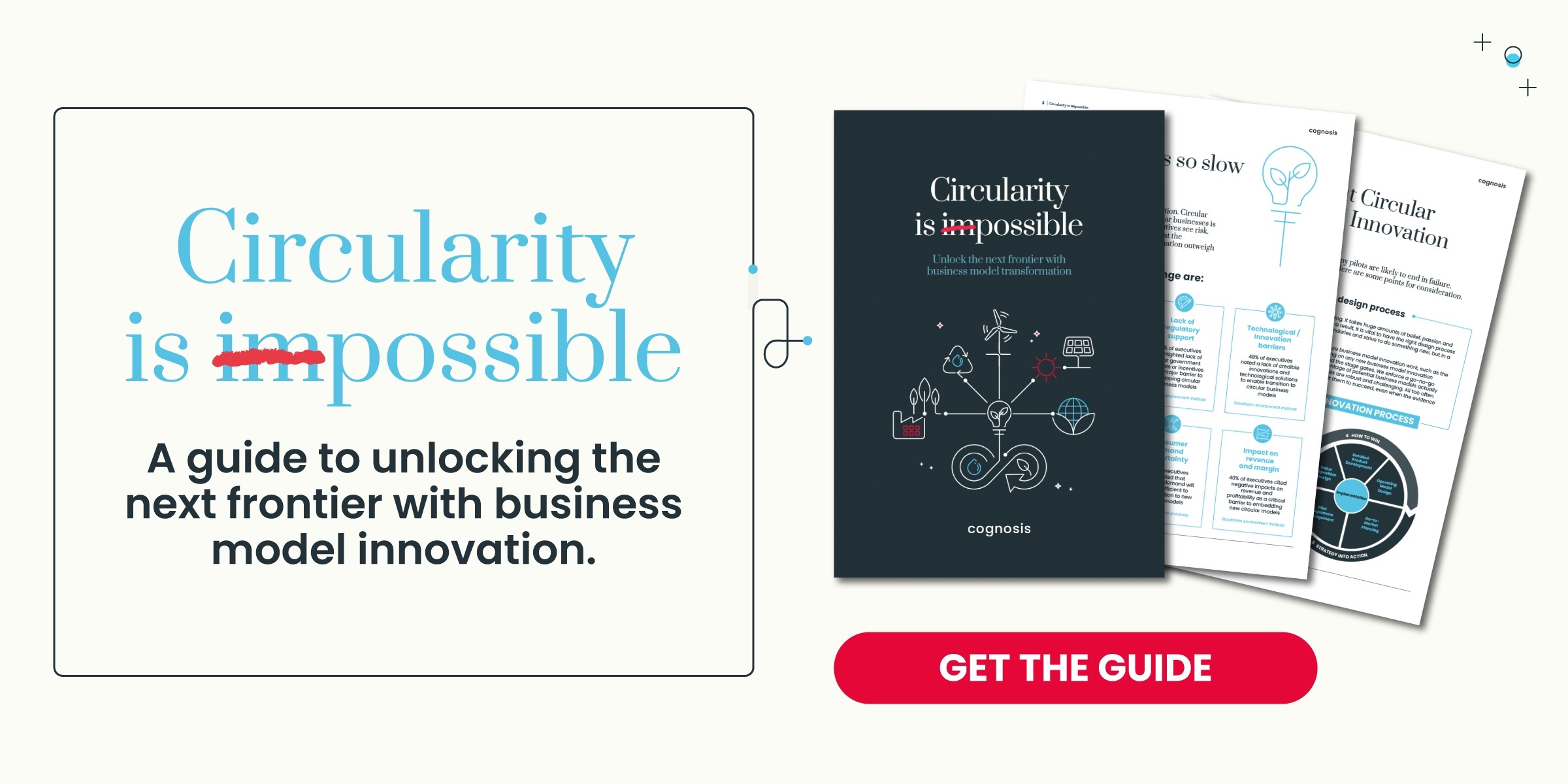4 Dimensions of Business Model Innovation for a Circular Economy
Exploring business model innovations that are already growing a customer base is a good place to start when considering the shift to a more circular economy. In this article, we look into four dimensions or types of innovation that start-ups and larger companies are developing to remain competitive and resilient into the future.

Circular innovation is a challenge that linear organisations will eventually need to confront, if they want to remain competitive and resilient into the future.
For linear businesses looking to join the circular economy, the most accessible route is by optimising their current value chain. Keeping materials in the system for as long as possible is better for the planet, while efficiencies and cost reductions make sense from a business perspective.
The other avenue into circularity is through business model innovation, which offers the incentive of greater long-term profitability and also resilience. However, there is an uncomfortable truth about circular innovation. Disrupting profitable linear business models can feel like a risk too far. CEOs will know that circular innovation is critical for the future health of the organisation, but the short-term implications of change are frightening.
> RELATED ARTICLE: 5 Major blockers to break for circular business model innovation
What types of innovation are most applicable?
Identifying the entry points to circularity is a good place to start when drawing up an innovation strategy. To make this process easier, Cognosis has created a catalogue of circular business model innovations filled with examples of both circular native start-ups and larger, traditionally linear companies that are enjoying real traction with consumers. Our database of insights is designed to inspire new ideas and fuel business model decisions in the future.
The headline news is that the pace of innovation is accelerating. While much is still being driven by start-ups, we are starting to see more circular business model innovation from large global linear businesses.
Our research reveals four distinct types of innovation that circular-minded businesses are currently developing:
- Anything as-a-service models
- Circular marketplaces
- Enabling services
- Recovery services
Here is an overview of those four models in action

1. Anything-as-a-Service (XaaS)
Products or services are offered on a subscription or pay-per-use basis rather than through traditional ownership, enabling resource efficiency through reuse and longer product lifecycles. XaaS can apply to physical products (e.g., cars, appliances) as well as software and IT infrastructure (e.g., SaaS or PaaS).
Car-sharing models such as Zipcar are a popular form of XaaS, as they invite customers to rent on demand rather than incur the financial and environmental costs of purchasing and maintaining a vehicle. Peer-to-peer models like Airbnb, famous for disrupting the hospitality industry, allow members to profit from underused assets – and then take a cut of the transaction fee.
Electronics giant Philips, founded in 1891, is showing the forward thinking that sits behind its durability with a lighting-as-a-service solution called Pay-Per-Lux. In this product-as-a-service model, clients pay for the light output rather than purchasing light bulbs.
Miele, the German appliance company, known for its high-quality engineering, rents out washing machines and tumble dryers on a subscription basis, taking on the costs of repair and regular upgrade.
As a circular native example, Rent The Runway is a subscription service that gives members access to a vast wardrobe of designer clothes for a monthly fee, not only saving money and offering unlimited variety, but also reducing the environmental footprint of being a dedicated follower of fashion.
2. Circular Marketplaces
These platforms facilitate the buying, selling and exchanging of second-hand, refurbished or recycled products. They promote the resale of goods rather than the production of new ones, ensuring that products continue to circulate in the market.
Circular marketplaces are centred around redistributing existing goods, unlike XaaS which focuses on providing access to goods over ownership. Revenue is made by charging commissions on sales, listing fees, or transaction fees.
For example, global platforms like eBay and Vinted permit customers to resell used goods like clothing, electronics, and furniture, rather than throw them in landfill (or leave them mouldering in the back of the shed/cupboard). In these peer-to-peer models, the platform never takes ownership of the product.
Back Market has found a solution to the demand for more affordable and sustainable gadgets by refurbishing products to their original condition. In this model, Back Market does take the risk of ownership, selecting products that it can sell on at a worthwhile profit.
B2B platforms like the Excess Material Exchange – as its name suggests – encourage companies to buy or sell surplus materials, equipment or components, which optimises resources and saves money at the same time.
3. Recovery Services
Through collection, repair, remanufacturing or recycling, these services close the loop in the product lifecycle. They prevent products from ending up in landfill and help recover valuable materials that can be reused in manufacturing, thereby reducing the need for virgin resources.
Recovery Services focus on the back end of the product lifecycle. TerraCycle is a successful example of a recycling company that processes hard-to-recycle materials, such as electronics or complex plastics. These are then broken down into raw materials and sold to manufacturers – reducing the buyer’s environmental footprint in the process.
California apparel retailer Patagonia is known for being a trailblazer in sustainable practices, and it’s little surprise that circularity is high on its agenda. The Worn Wear programme encourages customers to repair their old outdoor gear, including an outreach repair truck that meets customers in their local area.
The IKEA Buyback & Resell Service invites customers to return their used products, rather than putting them on platforms like eBay/Facebook Marketplace (or chucking them out). As part of the take-back arrangement, customers gain a voucher to spend in-store.
4. Enabling Services
Enabling Services are the moving parts behind circularity, providing tools and platforms for tracking, managing and optimising resources. Effectively, they allow the circular economy to function.
As the technological backbone of the circular economy, Enabling Services support the infrastructure needed for other circular models but they don’t directly engage in the sale, lease or recovery of products. For example, CircularIQ is a digital, data-driven platform that helps customers to track their product lifecycles, manage inventory or facility sharing and trading.
Happy Returns from UPS is a reverse logistics solution that assists the return, repair and recycling of products. Customers can return items in person at third-party locations called "Return Bars", without boxes or labels. UPS then ships the items, and customers receive their refunds instantly. Happy Returns is a good example of a major company acquiring an existing circular solution rather than building from scratch.
Blockchain is best known as a crypto currency technology, but its immutability is also a useful feature for tracing the provenance of products and materials across the supply chain, ensuring transparency for recycling and reuse. For example, IBM’s Sterling Transparent Supply solution and management system allows customers to transact with their supply chain partners in a more trusted and efficient way.
Now is the right time to start your circular strategy
Our library will need regular refreshing. As with other forces for business transformation, such as AI, the rate of change means that these business innovation models will themselves adapt, morph and branch out into new avenues of opportunity. As they do, so the wave of momentum behind circularity will continue to grow.
When we look back in 2050 or 2060, we may wonder how the world ever functioned in a linear way. Circularity will be the norm – and business will have led the change. Despite the daunting challenge of developing innovative circular business models, those who can pioneer and move first will gain competitive advantage - an advantage which will only increase over time.
Every business has the potential to find a circular proposition that fits their strategy – whether as developer, customer or both.
> BUILDING THE CASE FOR CIRCULARITY: Talk to us about achieving a circular advantage in your business


